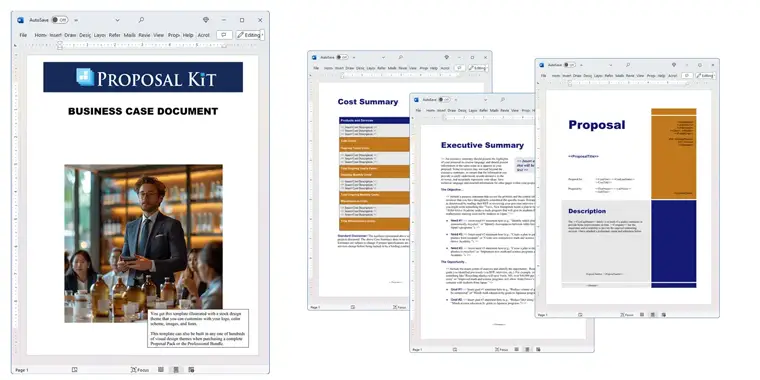How to write your Business Case Document
We include this 23 page layout with every Proposal Pack. If you want this template to have a different visual design theme than the one illustrated here, purchase any Proposal Pack design and create this template using the purchased design theme. This template is included in every Proposal Pack. If you get a Proposal Pack or the Professional, you can also make any variation of this template with different chapters to suit your needs.
We typically include more chapters in the templates than most people will need to give everyone more variety in the chapters they may need. You can trim down a long template by removing pages you do not need or combining multiple chapter topics into one page.
 DOWNLOADABLE, ONE-TIME COST, NO SUBSCRIPTION FEES
DOWNLOADABLE, ONE-TIME COST, NO SUBSCRIPTION FEESYou can also create countless variations of this document to suit your needs using the included library of 2200+ chapters if ordering a Proposal Pack or Professional.
 What Our Clients Say
What Our Clients SayThis product is amazing, I had to draft a proposal in a limited amount of time, I found this product ordered it and it worked perfectly. I nailed the client and will be using it again."
Redmond Legal Group
Related Article
Related Video
Related Templates
- Technology Strategy Analysis
- Investment Strategy Proposal
- Strategic Business Map
- Strategic Plan
- Case Study Report
- Strategic Alliance Proposal
- Business Strategy Change and Implementation Proposal
- Business Development Proposal
- Business Complaint And Solution Proposal Template
- FinTech Cost Benefit Analysis Proposal Template
- Records Management Analysis Proposal
- Due Diligence Project Proposal
- Market Access Recovery Proposal Template
- Records Management Survey Analysis
- Feasibility Study for Business Startup
- Standard Operating Procedure Document
- Purchasing Tablet Computers for Field Use Proposal
- Feasibility Study Report
- Growing Company Globally Proposal
Creating a Strong Business Case with Proposal Kit: A Comprehensive Guide
Starting a new project requires not just an idea, but a compelling business case. This article is a straightforward guide for anyone unfamiliar with the process of writing a business case, particularly using the Proposal Kit template library and Wizard software program to assemble a custom business case template.
Imagine you're about to embark on a significant project. Do you see the importance of a solid business case in your scenario?
What is the Best Way to Write a Business Case Document?
For those new to proposal writing, the Proposal Kit offers a comprehensive solution. The key steps are:
- Understand Your Needs: Clearly identify the project's purpose and requirements.
- Utilize Proposal Kit Templates: Access the extensive library of templates which are designed to cater to various business needs.
- Leverage the Wizard Software: This tool guides you step-by-step, ensuring all critical aspects of your business case are covered.
- Incorporate Financial Data: Use the integrated line item quoting database for accurate and detailed financial planning, including costs summaries, quotes, estimates, budgets, and more.
What Types of Projects Are Business Case Documents Written For?
Several projects necessitate a well-structured business case, such as:
- Launching a new product or service
- Expanding into new markets or regions
- Significant IT system upgrades or overhauls
- Large-scale marketing campaigns
- Strategic business partnerships or alliances
- Organizational restructuring
- Major procurement or outsourcing decisions
- Sustainability and environmental initiatives
- Research and development projects
- Mergers and acquisitions
Chapters this template is built with
Key templates that can enhance your business case include. A business case is essentially a proposal in that you are making a persuasive argument to make your case to an audience.
Each of these sections plays a crucial role in building a comprehensive and convincing business case. Together, they provide a detailed and structured approach to proposing, planning, and executing a project.
These are just a glimpse of the thousands of customizable templates available in Proposal Kit you have available to build into your custom business case template when using the Wizard software and this starting template.
Problem Statement
The Problem Statement is the foundation of your proposal. It succinctly identifies the specific issue or opportunity your project addresses. This statement should be clear and concise, highlighting the gap or need in the current situation that your project aims to fill. It sets the stage for the rest of the document by outlining the context and urgency of the problem.
Executive Summary
The Executive Summary is a snapshot of your entire proposal. It provides a high-level overview that includes the project's objectives, the approach to be taken, a brief mention of the expected outcomes, and the overall significance of the project. This section is critical as it's often the first (and sometimes only) part read by decision-makers. It should be compelling enough to engage the reader and encourage them to delve into the details of the proposal.
Justification
Justification explains the rationale behind the project. It answers the "why" of the proposal - why this project is necessary and why it should be undertaken now. This section should articulate the benefits of the project, addressing both the direct advantages and the indirect benefits, such as increased efficiency, cost savings, market expansion, or enhanced reputation.
Goals and Objectives
This section outlines the specific aims of the project. Goals are broad, overarching outcomes you hope to achieve, while objectives are measurable steps to reach these goals. Clear, well-defined goals and objectives provide a framework for the project and serve as benchmarks for success.
Expected Results
Expected Results describe what the project is anticipated to achieve upon successful completion. This goes beyond goals and objectives to paint a picture of the tangible and intangible outcomes. This could include increased revenue, market penetration, improved customer satisfaction, technological advancements, or social impact.
Milestones
Milestones are key checkpoints or significant stages in the project's timeline. They help in tracking progress and ensure the project stays on schedule. This section should detail what these milestones are, when they are expected to be achieved, and what constitutes successful completion of each milestone.
Project Plan
The Project Plan is a comprehensive blueprint of how the project will be executed. It includes methodologies, strategies, resource allocation, risk management plans, and contingency strategies. This plan should demonstrate a thorough understanding of the project scope and a realistic approach to achieving the project's objectives.
Project Analysis Overview
This provides an in-depth analysis of various aspects of the project, such as market analysis, competitive landscape, risk assessment, and technological considerations. It should present data and insights that support the feasibility and potential success of the project.
Impact Statement
The Impact Statement discusses the broader effects of the project. This could include social, economic, environmental, or industry impacts. It helps stakeholders understand the wider implications and benefits of the project, beyond immediate financial gains.
Alignment
Alignment shows how the project fits with the broader business goals or strategic objectives of the organization. This section should link the project to the company's vision, mission, and long-term strategy, demonstrating how it contributes to the overall direction of the organization.
Cost/Benefit Analysis
This offers a financial overview of the project, comparing the costs involved with the expected benefits. It should provide a detailed breakdown of project expenses, alongside a quantification of benefits in monetary terms. This analysis is crucial for decision-makers to assess the financial viability of the project.
Team Members
Here, you list the individuals involved in the project and their specific roles and responsibilities. This section should outline the structure of the project team, highlighting the skills and expertise each member brings. It assures stakeholders that the project has the right mix of talent and leadership to be successful.
Use cases for this template
Oliver's IT Expansion with Proposal Kit
Oliver, the owner of an IT firm, faced a pivotal moment in his business journey: expanding the company to offer cutting-edge services. He realized that to secure funding and stakeholder support, a compelling business case was essential. Using Proposal Kit, Oliver meticulously wrote his proposal.
He began with a detailed Market Analysis. Using templates from the Kit, he presented data on emerging IT trends, competitor analysis, and identified a gap in the market that his company could fill. This analysis was backed by hard data, making a strong case for the viability of the new services.
Next, Oliver projected Potential Revenue Growth. He used the financial templates to forecast revenue, incorporating various scenarios to cover a range of market responses. This section was crucial, showcasing the financial benefits in a clear, concise manner, which was particularly persuasive to his business partners.
Finally, Oliver addressed the Technical Feasibility of the new services. He detailed the technology requirements, the expertise of his team, and the implementation timeline. This section highlighted his team's capability to deliver the new services, assuring stakeholders of the project's success.
Oliver's business case, strengthened by Proposal Kit's comprehensive resources, succeeded in securing the necessary funding and support, paving the way for his company's expansion.
Maya's Rapid Response for a New Product Line
Maya, a strategic planner in a large corporation, faced a daunting task. She had to develop a business case for a new product line - and she had to do it fast. Proposal Kit was her tool of choice to meet this challenge.
She began by writing an Executive Summary, concisely outlining her vision for the new product line. Using the Kit's templates, she succinctly presented the opportunity and the strategic fit within the company's existing product portfolio.
Maya then moved on to Financial Projections. With the software's user-friendly financial templates, she developed detailed projections including cost analysis, pricing strategy, and revenue forecasts. This provided a clear picture of the financial implications and potential profitability of the new product line.
Market Research was her next focus. Maya utilized Proposal Kit's resources to compile data on customer demographics, market needs, and competitive landscape. This research demonstrated a clear market demand for the product, reinforcing the viability of the project.
Under a tight deadline, Maya's well-structured and data-driven business case, facilitated by Proposal Kit, was instrumental in swiftly getting the green light from her superiors.
Liam's Non-Profit Initiative for Regional Expansion
Liam, dedicated to his role in an international non-profit, recognized the need to expand their services into a new region. To make this vision a reality, he turned to Proposal Kit to create a persuasive business case.
He started with an Impact Statement, using the Kit's templates to articulate the societal benefits of the expansion. He highlighted how the non-profit's services would address specific regional needs, improve lives, and contribute to community development.
Resource Requirements were meticulously detailed next. Liam used the Kit to lay out the staffing needs, infrastructure, and funding necessary for the expansion. This thorough planning demonstrated his understanding of the scale and scope of the initiative.
The Potential Impact of the expansion was a critical part of Liam's proposal. He used data and case studies to project the long-term benefits of the expansion, not only for the target region but also for the non-profit's global mission.
Liam's business case, supported by the robust tools of Proposal Kit, effectively communicated the importance and feasibility of the expansion. It played a key role in gaining support from key stakeholders, ensuring the success of the non-profit's ambitious initiative.
Conclusions and Recommendations
Oliver, Maya, and Liam's stories highlight the versatility and effectiveness of Proposal Kit in various scenarios. By providing comprehensive templates and tools, Proposal Kit simplifies the process of creating detailed and persuasive business cases across different industries and project types. Whether you're a small business owner, a corporate employee, or a non-profit volunteer, Proposal Kit can be your ally in making a compelling argument for your project. Remember, a well-written business case is not just a document; it's a roadmap to your project's success.
Also Known As
This template may also be referred to in different ways or be used in more specialized situations, such as:
- Business Justification Document
- Project Proposal
- Investment Appraisal
- Business Plan
- Value Proposition Document
- Feasibility Study Report
- Cost-Benefit Analysis Report
- Strategic Business Plan
- Project Charter
- Financial Justification Report
Abstract
 Creating a strong business case is crucial for project success, serving as a tool that aligns business objectives with proposed initiatives. For organizations, the Proposal Kit offers a comprehensive guide to building a well-written business case, particularly for those unfamiliar with the process. This guide emphasizes using a business case template, along with the Proposal Kit's Wizard software, to construct a tailored business proposal. Business case documents are important for various projects, ranging from launching new products to business partnerships. A business case helps define project goals, perform a financial assessment, and conduct sensitivity analysis to evaluate potential risks and benefits. By using the Proposal Kit templates, project managers and relevant stakeholders can generate a business case that includes detailed project definitions, financial appraisals, and expected outcomes, ensuring that the project's significance is fully understood and approved by the management team and project sponsor.
Creating a strong business case is crucial for project success, serving as a tool that aligns business objectives with proposed initiatives. For organizations, the Proposal Kit offers a comprehensive guide to building a well-written business case, particularly for those unfamiliar with the process. This guide emphasizes using a business case template, along with the Proposal Kit's Wizard software, to construct a tailored business proposal. Business case documents are important for various projects, ranging from launching new products to business partnerships. A business case helps define project goals, perform a financial assessment, and conduct sensitivity analysis to evaluate potential risks and benefits. By using the Proposal Kit templates, project managers and relevant stakeholders can generate a business case that includes detailed project definitions, financial appraisals, and expected outcomes, ensuring that the project's significance is fully understood and approved by the management team and project sponsor.
In the early stages of developing a business case, it is vital to gather input from various departments and consult subject matter experts to ensure clarity and relevance. A well-structured business case explains the business problem and outlines the proposed solution, emphasizing the costs, benefits, and project risks involved. By using the Proposal Kit's templates, you can organize your project schedule, align it with the organization's mission statement, and highlight the success criteria that define project success. The financial section should include a comprehensive financial appraisal outlining project costs, expected costs, and potential cash flow to provide a clear picture of the project's return on investment (ROI). Moreover, a SWOT analysis, stakeholder analysis, and risk analysis should be conducted to prepare for any risks associated with the project. By presenting a thorough business case, businesses can justify the need for the proposed business change, gain stakeholder buy-in, and secure the necessary financial and other resources. The Proposal Kit simplifies the process of creating a business case, making it a valuable tool for anyone looking to pitch a new initiative or decision.
Creating a robust business case is the cornerstone of effective project management and decision-making. It acts as a blueprint for addressing a business problem and a viable solution. By using the Proposal Kit, which includes a rich library of business case templates and the Wizard software, project managers can create a well-structured business proposal that meets the organization's business strategy and objectives. This toolset provides a high-level outline for developing a business case, making it suitable for projects such as mergers and acquisitions, IT system upgrades, and sustainability initiatives.
 The Proposal Kit ensures that every project component, from the project description to the business case checklist, is addressed with enough detail to satisfy relevant stakeholders. The process begins with establishing a clear problem statement, which serves as the foundation for the entire business case. The executive summary follows, offering a brief overview of the project's goals, expected outcomes, and its alignment with the organization's mission statement and objectives.
The Proposal Kit ensures that every project component, from the project description to the business case checklist, is addressed with enough detail to satisfy relevant stakeholders. The process begins with establishing a clear problem statement, which serves as the foundation for the entire business case. The executive summary follows, offering a brief overview of the project's goals, expected outcomes, and its alignment with the organization's mission statement and objectives.
Conducting a financial assessment is vital, including a detailed cost-benefit analysis, cash flow projections, and sensitivity analysis. This step helps in evaluating the project's financial viability and expected return on investment (ROI). The finance section should be comprehensive, covering project costs, project budget, and alternative approaches to ensure the project's feasibility and success.
A well-written business case also involves conducting a thorough market assessment and stakeholder analysis. Consulting subject matter experts and involving appropriate team members from different departments can provide valuable insights and ensure that all relevant perspectives are considered. This collaborative approach helps in defining the project's scope, identifying potential project risks, and developing a risk management plan.
 In addition to financials, the business case should outline the project's implementation strategy, detailing the methodologies, resource allocation, and project governance structures. Progress reporting and stakeholder engagement are crucial for maintaining transparency and ensuring that all parties remain on the same page throughout the project's lifecycle.
In addition to financials, the business case should outline the project's implementation strategy, detailing the methodologies, resource allocation, and project governance structures. Progress reporting and stakeholder engagement are crucial for maintaining transparency and ensuring that all parties remain on the same page throughout the project's lifecycle.
The Proposal Kit also offers a step-by-step guide for creating an effective business case. You should also include a Gantt chart to visualize the project schedule and milestones. This comprehensive overview provides a clear roadmap for implementing the proposed business change, ensuring that the initiative aligns with the organization's broader goals and business functions.
By following best practices and using the Proposal Kit's resources, organizations can prepare a persuasive and well-structured business case that convincingly justifies the need for investment, outlines potential business benefits, and secures the necessary buy-in from stakeholders. Whether you're developing a business plan or a feasibility study report, the Proposal Kit equips you with the tools and templates needed to deliver a successful project proposal.
Frequently Asked Questions
What is the purpose of a business case document?
A business case document provides a comprehensive justification for initiating a project or investment. It outlines the rationale, benefits, costs, risks, and expected outcomes, helping stakeholders make informed decisions. It is a decision-making tool that evaluates whether the proposed project aligns with organizational goals and offers sufficient value to warrant the investment.
What should a business case document include?
A well-structured business case document should include several key elements: an executive summary, problem or opportunity statement, project objectives, options analysis, cost-benefit analysis, risk assessment, implementation timeline, and recommendations. Each section should be detailed enough to clearly understand the project's scope, benefits, and potential challenges, ensuring that stakeholders have all the necessary information to decide.
How do I conduct a cost-benefit analysis for my business case?
Conducting a cost-benefit analysis involves identifying and quantifying all the costs and benefits associated with the project. Start by listing all potential costs, including initial investment, operational, and indirect costs. Then, estimate the financial and non-financial benefits, such as increased revenue, cost savings, efficiency improvements, and advantages. Compare the total costs against the total benefits to determine the project's overall value. This analysis helps demonstrate the project's financial viability and potential ROI.
How should I address risks in my business case?
Addressing risks in a business case involves identifying potential risks, assessing their likelihood and impact, and proposing mitigation strategies. Begin by listing all possible risks, including financial, operational, strategic, and external factors. Evaluate the probability and potential impact of each risk and prioritize them accordingly. Provide mitigation strategies for high-priority risks, detailing how they will be managed or minimized. A thorough risk assessment assures stakeholders that potential challenges have been considered and planned for.
Who is the intended audience for a business case document?
The intended audience for a business case document typically includes vital decision-makers such as executives, project sponsors, stakeholders, and sometimes external investors or partners. These individuals are responsible for approving the project and allocating resources. Therefore, the document should be written clearly, concisely, and persuasively, addressing their concerns and providing the necessary information to facilitate a well-informed decision.
20% Off Discount
![]() Add To Cart This Word Template
Add To Cart This Word Template
 Add To Cart Proposal Pack for Any Business
Add To Cart Proposal Pack for Any Business
 Add To Cart Proposal Kit Professional
Add To Cart Proposal Kit Professional
 4.7 stars, based on 849 reviews
4.7 stars, based on 849 reviewsProposal Kit chapters used in this template
Title Page, Table of Contents, Executive Summary, Synopsis, Expected Results, Recommendations, Justification, Team Members, Problem Statement, Impact Statement, Migration, Project Analysis Overview, Project Plan, Goals and Objectives, Performance, Assumptions, Project Constraints, Milestones, Alignment, Cost/Benefit Analysis, Alternatives, Approval, Back Page
Line Item Automated Chapters
If you purchase a Proposal Pack or the Professional Bundle, these proposal pages are generated using an automated line-item database in the included Wizard software.
Cost Benefit Analysis
You use this proposal for
- Business plan, loan, investor funding proposal
- Internal company proposal
- Business document, study, plan, report
How to create this template with Proposal Pack Wizard
You can create this document using any of the logo-designed Proposal Packs. Pick any Proposal Pack with a logo design theme you like best; they will all work equally well. The Proposal Pack for Any Business is the pack with no extra added logos or colors - designed to be used plain or for you to customize with your logos and graphics.
The Proposal Pack design theme you purchase will determine the visual look of this template. The screenshot above only shows the plain generic design theme.
We include a library of chapters to be assembled based on your needs. All proposals are different and have different needs and goals. We designed Proposal Pack so you can customize the documents to suit your needs.
You will best create this document using the Proposal Pack Wizard - Expert Edition software to select this template and build it in the Proposal Pack logo design theme of your choice along with any desired customizations (such as adding additional chapters, removing unneeded chapters, changing the order of chapters, and importing your company logo). This template outlines a proposal for the described situation. Each user is responsible for typing in the actual content of the provided pages with their information to complete the proposal. Suggestions in the abstract may include features in higher-end packages and are facilitated by the selection of chapter templates to support the narrative of each proposal, which help guide the user in filling in the details.
The Wizard software's AI Writer will write the content of the pages of the template based on details provided for your company, client, project, financial details and other writing instructions. This will provide a personalized version of the template completely written and ready to edit.
Once finished, the AI Writer's Word-to-PowerPoint converter can transform your proposal, business plan, or other business documents into a PowerPoint slideshow. Save time and effort by letting the AI analyze every chapter to condense its content into talking points, visually matching the document, and providing a consistent package of presentation material with the click of a button.
You create this template using the Wizard software with an entire Proposal Pack library and software. We include the Expert Edition of the software in the Proposal Kit Professional. Microsoft Word for Windows is required to use the customizing software. You can also edit Word document templates in other office software such as Word for Mac. We will assist Mac users in assembling complex templates for their first project if they do not have the required platform to run the Wizard software.
How to Build Templates Featured on Proposal Kit Website
Many people find the Proposal Kit website after searching for a specific proposal. Once you've purchased and installed the software, how do you build that template you found in the first place? This video shows you how to build any proposal you see on the Proposal Kit website.
 Ian Lauder has been helping businesses write their proposals and contracts for two decades. Ian is the owner and founder of Proposal Kit, one of the original sources of business proposal and contract software products started in 1997.
Ian Lauder has been helping businesses write their proposals and contracts for two decades. Ian is the owner and founder of Proposal Kit, one of the original sources of business proposal and contract software products started in 1997.By Ian Lauder
 Published by Proposal Kit, Inc.
Published by Proposal Kit, Inc.


 Cart
Cart
 Get 20% off ordering today:
Get 20% off ordering today: 


 Facebook
Facebook YouTube
YouTube Bluesky
Bluesky Search Site
Search Site